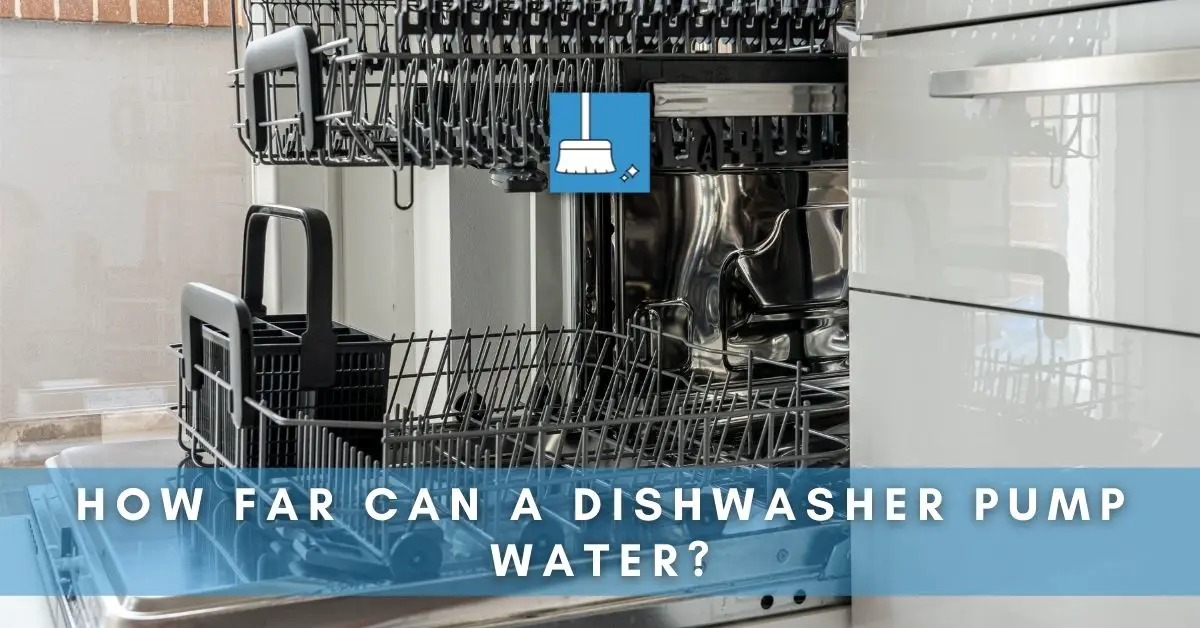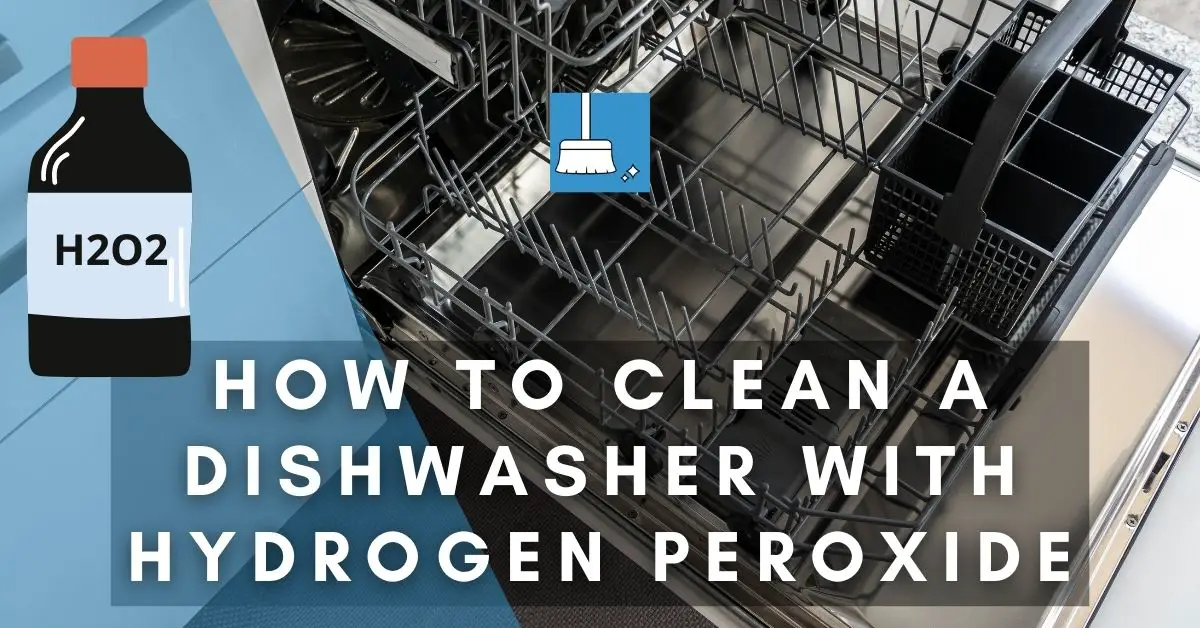People encounter many problems such as water being backed up by the sink into the dishwasher, not having space near the sink to install a dishwasher. These issues make you want to install dishwashers in unconventional spaces.
However, as the location of the dishwasher is so important in order to improve its efficiency, you need to keep it in the right place in the first place.
This article explains how far can the dishwasher pump water, the location rules, How high it can be, what to do when it does not drain properly, and more.
How Far Can a Dishwasher Pump Water?
How far a dishwasher pumps water depends on how long the drain line is. The standard dishwasher comes with a 6-foot 6-inch drain line and most lines can be extended to 10-12 inches depending on the make and model of the dishwasher.
An extra-length drain hose of 18 inches can be purchased, but it is recommended to install a check valve when using an extra-length drain hose in order to prevent any damage.
Some dishwasher manufacturers also have an extra drain line extender that can be purchased in order to extend the length and the distance over which the water can be pumped.
It is however recommended that the distance over which a dishwasher pumps water, be kept to a minimum in order to improve the effectiveness of the dishwasher.
The length over which the dishwasher can pump water is also affected by the make and model of the dishwasher in terms of how powerful the dishwasher is. A more powerful dishwasher will be able to pump water further.
Dishwashers have release pumps, suggesting their water is powerfully ejected from the unit, which expands the distance that you can run the drain hose.
Dishwasher Location Rules
There are a few things to consider when placing your dishwasher in your kitchen. These aspects can have an effect on the efficiency of the dishwasher. The location rules are as follows:
1- Place the Dishwasher Next to the Sink
It is however best to place the dishwasher next to the sink, on the left or right-hand side, due to the fact that the distance over which water should be pumped, will be limited.
a. This will decrease the caseload on your dishwasher which will in turn limit breakages and repairs needed for the dishwasher.
b. This will also help you to save time when you dispose of leftover food in the garbage disposal before putting a plate in the dishwasher.
Placing a dishwasher next to the sink is not always possible when there is no space next to the sink or when the kitchen is too small.
2- Make Sure the Hose Is Elevated
When positioning your dishwasher in your kitchen, it is important to ensure that the hose used for drainage, is elevated off the floor. This is in order to ensure that no wastewater can infiltrate the mechanism.
If there is a small step, it would be good to consider positioning your dishwasher close to the step in order to elevate the drainage hose. If there is no step, a plastic stool can be purchased in order to aid with this matter.
3- Ensure There Is Enough Space in Front of the Dishwasher
A dishwasher is frequently opened and closed when packing in dirty dishes and packing out clean dishes.
It is important to ensure that there is nothing blocking the front of the dishwasher to prevent it from bumping into something when opened. This will prevent damage to the dishwasher.
If possible, it is important to ensure that there is enough space for a person to stand and bend down in front of the dishwasher to pack in and empty the dishes.
4- It Must Be Placed near the Power Supply
It is recommended to position the dishwasher as close to the power supply and the plug as possible.
You can insert the dishwasher directly into the power outlet instead of using a lead because if a lead is not positioned correctly, it can be a hazard in the kitchen as you can fall over it.
The power cable should be elevated from the ground in order to prevent it from getting damaged by water if there is a possible leak.
5- It Should Not Be Too Close to the Wall
It is not recommended to position a dishwasher closer than 2 feet to the wall due to the moisture and heat that builds up when the dishwasher is operating. Having a dishwasher too close to the wall can result in a build-up of mold which can damage the dishwasher.
How High Can a Dishwasher Pump Water?
The standard dishwasher is able to pump water 7 to 8 feet in an upwards motion. There is usually a high loop between the dishwasher and the area where it connects to the sink. The high loop is necessary in order to prevent the drain water from entering the dishwasher again.
The distance over which a dishwasher pumps water upwards depends on the make and model of the dishwasher. A dishwasher that is very powerful, will be able to pump water higher than the average dishwasher.
How Far Can a Dishwasher Be from the Sink?
It is generally recommended that a dishwasher be placed between 6 feet and 12 feet from the sink for optimal functioning. This distance can however be increased when the drainage hose is extended.
It is not recommended to place the dishwasher too far from the sink due to the fact that the distance over which the water should be pumped is increased. Some dishwasher that is not powerful, will not be able to pump water over a long distance.
Dishwasher Drain Not near the Sink (What to Do?)
In order to install a dishwasher that is not near a sink, the first thing that should be done is to run separate water supply lines to the dishwasher.
If the dishwasher is not able to heat the water on its own, the water should run from the hot water heater directly toward the dishwasher.
When a dishwasher is not near the sink, a separate drainage system should be created. This can be done by various methods such as a standpipe, a dual air gap, or a trap.
It is important that the dishwasher drain should be connected to some form of a drainage system via the shortest route. This is necessary in order to prevent any damage to the system. If your house has a basement, it would be recommended to install a trap or waste tee through the basement.
When installing a separate drainage system, you will often have to drill a hole through a cabinet or a wall, so ensure that you have the right tools before starting the project.
Can a Dishwasher Have Its Own Drain?
Yes, it is possible for a dishwasher to have its own drain by creating an independent drainage system. A trap or waste tee can be installed in order to drain dirty water from the dishwasher.
Installing a Trap or Waste Tee for the Dishwasher!
The most important aspect to note when installing a strap or waste tee for a dishwasher is that the drain hose must be connected to some area of the drainage system. The shortest way from the dishwasher to the drainage system should be found in order to prevent unnecessary complications within the kitchen.
Step 1 – Connect a drain hose to the dishwasher. Find the area where the drain hose should go through. If it is a wall or a cabinet, a hole should be made in the area at the right height for the drain hose.
Step 2 – When draining through the basement, an extension pipe will often be required in order to ensure that there is enough length between the dishwasher and the waste tee.
Step 3 – Include a joiner for the drain hose that is able to fit the appropriate size waste tee.
Step 4 – Route the drain hose through the joiner. Use glue on the different fitters in order to ensure that all different parts are properly connected.
Step 5 – Do a test run in order to ensure that there are no leaks in the newly installed system.
Optional – A mini vent can be attached to the drainage hose in order to prevent bad odors within the household.
If you do not have experience in this regard, it is always recommended to use a plumber.
Why Won’t My Dishwasher Pump Water?
There are a variety of reasons that the dishwasher does not pump water, such as:
1- It is not filling up with water: When the water inlet valve is defective, the dishwasher will not get any water. This will result in the dishwasher not being able to pump water outwards. You can inspect the valve and if there is any damage, it should be replaced.
2- The drain hose or sink is blocked: When the drain hose or sink is blocked, water is pumped over a short distance, but cannot be pumped out and will most likely move back into the dishwasher which can damage the dishwasher. It is recommended to clean the drainage hose and the sink regularly in order to prevent blockages.
3- The drain pump is damaged: Built-up grease and leftover food can block a drain pump if it is not cleaned regularly. Foreign objects such as broken glass can also result in the drain pump being damaged or blocked.
To check the drain pump, you would need to access the bottom of the dishwasher.
It is recommended to contact a qualified plumbing technician if you experience problems with your dishwasher in order to prevent voiding the appliance warranty.
What to Do When the Dishwasher Drain Hose Is Too Long?
When a dishwasher drain hose is too long, it can contribute to contaminated water flowing back into the dishwasher. Here is how to fix the problem:
Air Gap
An air gap can be purchased online or from a local hardware store.
1- If there is not an air gap hole underneath the sink, a new one should be made.
2- Connect the drain hose to the smaller side of the air gap. Connect the wastewater line to the other side of the air gap.
3- When completed, push the air gap through the hole in the counter. Ensure that it is secured and do a test run.
Conclusion!
A dishwasher can drain about 6-7 feet far but this is not set in stone. The drain line can be extended.
Make sure to follow the dishwasher location rules that we have given.





